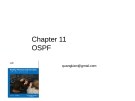
Types of OSPF routers
-
After studying this chapter you will be able to: Explain why multiarea OSPF is used, explain how multiarea OSPF uses link-state advertisements in order to maintain routing tables, explain how OSPF established neighbor adjacencies in a multiarea OSPF implementation,...
 43p
43p  youcanletgo_01
youcanletgo_01
 04-01-2016
04-01-2016
 52
52
 3
3
 Download
Download
-
In this chapter, you learned to: Describe OSPF terminology and operation within various enterprise environments, describe the function and operation of packets in OSPF routing, configure and verify basic OSPF, describe and configure OSPF in various WAN network types,...
 192p
192p  youcanletgo_01
youcanletgo_01
 29-12-2015
29-12-2015
 41
41
 2
2
 Download
Download
-
Type: OSPF packet type: Hello (Type 1), DBD (Type 2), LS Request (Type 3), LS Update (Type 4), LS ACK (Type 5). Router ID: ID of the originating router. Area ID: Area from which the packet originated. Network Mask: Subnet mask associated with the sending interface. Hello Interval: Number of seconds between the sending router’s Hellos. Router Priority: Used in DR/BDR election (discussed later). Designated Router (DR): Router ID of the DR, if any. Backup Designated Router (BDR): Router ID of the BDR, if any. List of Neighbors: Lists the OSPF Router ID of the neighboring router(s)...
 111p
111p  vanmanh1008
vanmanh1008
 21-05-2013
21-05-2013
 52
52
 4
4
 Download
Download
-
Chapter 11 OSPF quangkien@gmail.com .For further information This presentation is an overview of what is covered in the curriculum/book. For further explanation and details, please read the chapter/curriculum. Book: Routing Protocols and Concepts By Rick Graziani and Allan Johnson ISBN: 1-58713-206-0 ISBN-13: 978-58713206-3 2 .
 111p
111p  vanmanh1008
vanmanh1008
 21-05-2013
21-05-2013
 68
68
 5
5
 Download
Download
-
Link-State Routing Process 1. Each router learns about its own links, its own directly connected networks. (Interface is “up”) 2. Each router is responsible for meeting its neighbors on directly connected networks. (OSPF Hello packets) 3. Each router builds a link-state packet (LSP) containing the state of each directly connected link. (neighbor ID, link type, and bandwidth) 4. Each router floods the LSP to all neighbors, who then store all LSPs received in a database. Neighbors then flood the LSPs to their neighbors until all routers in the area have received the LSPs. 5.
 51p
51p  vanmanh1008
vanmanh1008
 21-05-2013
21-05-2013
 69
69
 6
6
 Download
Download
CHỦ ĐỀ BẠN MUỐN TÌM

















